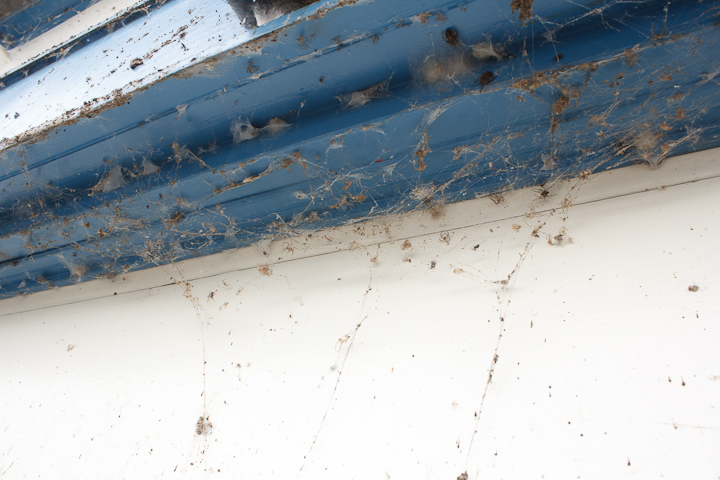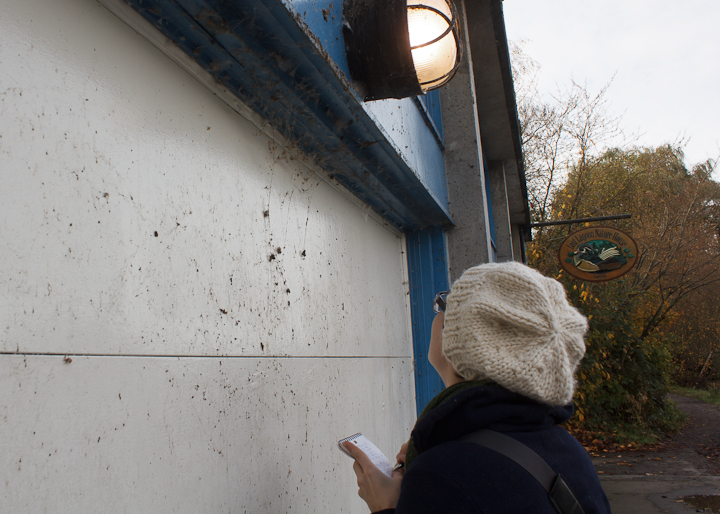This weekend, I was lucky to spend a rare rain-free November morning in Vancouver’s famous Stanley Park with Sean McCann, who kindly provided all the photos for this post. Despite the late season and cool weather, it turned out to be a very spidrous (a term coined by Sean) day indeed! We must remember that the end of Arachtober does not necessarily mean the end of spider season, as Eric Eaton pointed out in a recent Spider Sunday post.
Our first spider-observation stop was outside the Lost Lagoon Nature House. What at first glance looked like a dirty and unremarkable garage door turned out, upon closer inspection, to be a veritable spider heaven!
Although not quite on the massive scale of the aggregation of thousands of orbweavers inside a wastewater treatment plant that Gwen Pearson wrote about recently, I estimate that the area around this single garage door is home to several hundred spiders all living in extremely close proximity. In this case, the aggregated webs are just a couple metres away from the edge of Lost Lagoon, a freshwater habitat that produces large numbers of chironomid midges as well as larger aquatic insects. Lights attract these insects, making this the perfect hunting ground at night, when the spiders are most active.

It’s hard to see individual spiders at this scale, but looking closer, they are everywhere!
Here’s a closer look at one small area of the door (zooming in on the upper right corner of the photo above). Two large females rest in the open while a third hides away in a silken retreat next to a cluster of 3 egg sacs.
Almost all the spiders in this aggregation were members of a single species, the bridge orbweaver Larinioides sclopetarius (family Araneidae). Here are some closer shots of a male and female:

Female Lariniodes sclopetarius posing on some nearby vegetation.
We did find a few spiders other than bridge orbweavers on the building. A female L. sclopetarius and what’s most likely a juvenile Eratigena (formerly Tegenaria) appeared to be sharing the same retreat in a cement pillar.

Moments before this photo was taken, these two were hunkered down close together in the pit in the cement, apparently oblivious to one another.
Right on the other side of the same pillar, this male longjawed orbweaver Tetragnatha elongata was hanging out.
It turns out that Lariniodes and Tetrgnatha are the usual suspects when it comes to communal living and megawebs. Spiders in both genera like to live near water as was the case here next to the lagoon. Lariniodes sclopetarius often build their webs on human-made structures, and especially prefer to be next to lights (Greene et al. 2010 and references therein). This preference was very evident at the Nature House – of the four identical garage door sections of the side of the building facing the lagoon, the spiders were almost exclusively living on the only one with a light.
Although our first stop provided plenty of arachnological excitement for one day, we eventually moved on and explored the rest of the lagoon.
We found this male Pimoa altioculata and several others of the same species on webbing underneath the railing of a small footbridge.
When Sean removed the spider from his web to try to get some better shots, he immediately went into “play dead” mode, tucking all his legs up tightly around his body for defense.
Several more longjawed orbweavers were hanging out under the railings of the same bridge.
We also found this beautiful example of a hammock-shaped sheet web built by a small linyphiid.
We admired the web for some minutes before noticing the resident spider, who eventually came out onto the web for the lovely shot below:

You can tell from the bulbous pedipalps that this is a subadult male. I am pretty sure the species is Neriene digna.
All in all it was a wonderful day at the park. I hope your November is just as spidrous as ours has been so far here on the wet coast!
Reference:
Greene, A., Coddington, J. A., Breisch, N. L., De Roche, D. M., & Pagac, B. B. (2010). An Immense Concentration of Orb-Weaving Spiders With Communal Webbing in a Man-Made Structural Habitat (Arachnida: Araneae: Tetragnathidae, Araneidae). American Entomologist, 56(3), 146-156.









Glad to learn of your blog! I became a spider aficionado after spotting an emergence of American House spiderlings outside my door. I have a Twitter account for my spider photos @Araneae2
Thanks Douglas! I’ll be following your twitter account to see more of your spider shots!